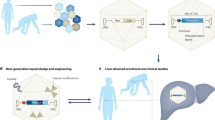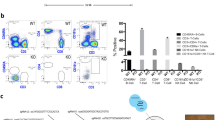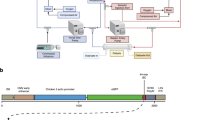Abstract
Liver gene therapy is being developed as an alternative to orthotopic liver transplantation, which is the only effective therapy for many liver diseases. The liver has unique features that make it attractive for in vivo and ex vivo gene transfer. In vivo approach is far less invasive than ex vivo approach, although in most cases, host immune response directed against the transgene product and/or vector particles severely impairs the efficiency of gene transfer, and precludes long-term transgene expression after in vivo gene delivery. Ex vivo approach allows for an elective targeting of the hepatocytes, avoiding that the transgene be expressed in professional antigen-presenting, but is faced with the low in vitro proliferative ability of hepatocytes, and to the low in vivo liver repopulating ability of transplanted cells. In some specific situations where immune response was controlled or transplanted cells had a strong growth advantage over host hepatocytes, gene transfer resulted in long-term and complete correction of a liver genetic defect. In this review, we will outline the liver diseases that may benefit from gene therapy, the vector technology under investigation, the advances and the problems to be overcome.
This is a preview of subscription content, access via your institution
Access options
Subscribe to this journal
Receive 12 print issues and online access
$259.00 per year
only $21.58 per issue
Buy this article
- Purchase on Springer Link
- Instant access to full article PDF
Prices may be subject to local taxes which are calculated during checkout
Similar content being viewed by others
References
Overturf K et al. Hepatocytes corrected by gene therapy are selected in vivo in a murine model of hereditary tyrosinaemia type I. Nat Genet 1996; 12: 266–273.
De Vree J M et al. Correction of liver disease by hepatocyte transplantation in a mouse model of progressive familial intrahepatic cholestasis. Gastroenterology 2000; 119: 1720–1730.
Yoshida Y et al. Intrahepatic transplantation of normal hepatocytes prevents Wilson's disease in Long-Evans cinnamon rats. Gastroenterology 1996; 111: 1654–1660.
Song E et al. RNA interference targeting Fas protects mice from fulminant hepatitis. Nat Med 2003; 9: 347–351.
Majno P et al. Adult-to-adult living-donor liver transplantation. A summary of current status and an outline of the program in Geneva. Swiss Surg 2003; 9: 227–236.
Toso C et al. Potential impact of in situ liver splitting on the number of available grafts. Transplantation 2002; 74: 222–226.
Mulligan R . The basic science of gene therapy. Science 1993; 260: 926–932.
Michalopoulos G, De Frances M . Liver regeneration. Science 1997; 276: 60–66.
Alvarez-Dolado M et al. Fusion of bone-marrow-derived cells with Purkinje neurons, cardiomyocytes and hepatocytes. Nature 2003; 425: 968–973; Epub 2003 Oct 12.
Vassilopoulos G, Wang PR, Russell DW . Transplanted bone marrow regenerates liver by cell fusion. Nature 2003; 422: 901–904.
Wang X et al. Cell fusion is the principal source of bone-marrow-derived hepatocytes. Nature 2003; 422: 897–901.
Thorgeirsson SS, Grisham JW . Overview of recent experimental studies on liver stem cells. Semin Liver Dis 2003; 23: 303–312.
Arbuthnot PB et al. In vitro and in vivo hepatoma cell-specific expression of a gene transferred with an adenoviral vector. Hum Gene Ther 1996; 7: 1503–1514.
Bilbao R et al. A blood–tumor barrier limits gene transfer to experimental liver cancer: the effect of vasoactive compounds. Gene Therapy 2000; 7: 1824–1832.
Gerolami R et al. Enhanced in vivo adenovirus-mediated gene transfer to rat hepatocarcinomas by selective administration into the hepatic artery. Gene Therapy 1998; 5: 896–904.
Wu GY, Wu CH . Receptor-mediated gene delivery and expression in vivo. J Biol Chem 1988; 263: 14621–14624.
Chowdhury NR et al. Microtubular disruption prolongs the expression of human bilirubin-uridinediphosphoglucuronate-glucuronosyltransferase-1 gene transferred into Gunn rat livers. J Biol Chem 1996; 271: 2341–2346.
Erbacher P et al. Gene transfer by DNA/glycosylated polylysine complexes into human blood monocyte-derived macrophages. Hum Gene Ther 1996; 7: 721–729.
Budker V et al. Naked DNA delivered intraportally expresses efficiently in hepatocytes. Gene Therapy 1996; 3: 593–598.
Herweijer H, Wolff JA . Progress and prospects: naked DNA gene transfer and therapy. Gene Therapy 2003; 10: 453–458.
Jaffe HA et al. Adenovirus-mediated in vivo gene transfer and expression in normal rat liver. Nat Genet 1992; 1: 372–378.
Li QT et al. Assessment of recombinant adenoviral vectors for hepatic gene therapy. Hum Gene Ther 1993; 4: 403–409.
Jooss K, Ertl HC, Wilson JM . Cytotoxic T-lymphocyte target proteins and their major histocompatibility complex class I restriction in response to adenovirus vectors delivered to mouse liver. J Virol 1998; 72: 2945–2954.
Jooss K, Yang Y, Wilson JM . Cyclophosphamide diminishes inflammation and prolongs transgene expression following delivery of adenoviral vectors to mouse liver and lung. Hum Gene Ther 1996; 7: 1555–1566.
Yang YP et al. Transient subversion of CD40 ligand function diminishes immune responses to adenovirus vectors in mouse liver and lung tissues. J Virol 1996; 70: 6370–6377.
Kay MA et al. Transient immunomodulation with anti-CD40 ligand antibody and CTLA4Ig enhances persistence and secondary adenovirus-mediated gene transfer into mouse liver. Proc Natl Acad Sci USA 1997; 94: 4686–4691.
Ilan Y et al. Transient immunosuppression with FK506 permits long-term expression of therapeutic genes introduced into the liver using recombinant adenoviruses in the rat. Hepatology 1997; 26: 949–956.
Schiedner G et al. Genomic DNA transfer with a high-capacity adenovirus vector results in improved in vivo gene expression and decreased toxicity. Nat Genet 1998; 18: 180–183.
Ilan Y et al. Insertion of the adenoviral E3 region into a recombinant viral vector prevents antiviral humoral and cellular immune responses and permits long-term gene expression. Proc Natl Acad Sci USA 1997; 94: 2587–2592.
Ehrhardt A et al. A gene-deleted adenoviral vector results in phenotypic correction of canine hemophilia B without liver toxicity or thrombocytopenia. Blood 2003; 102: 2403–2411; Epub 2003 Jun 12.
Brown BD et al. Helper-dependent adenoviral vectors mediate therapeutic factor VIII expression for several months with minimal accompanying toxicity in a canine model of severe hemophilia A. A gene-deleted adenoviral vector results in phenotypic correction of canine hemophilia B without liver toxicity or thrombocytopenia. Blood 2004; 103: 804–810; Epub 2003 Sep 25.
Mingozzi F et al. Induction of immune tolerance to coagulation factor IX antigen by in vivo hepatic gene transfer. J Clin Invest 2003; 111: 1347–1356.
Snyder RO et al. Correction of hemophilia B in canine and murine models using recombinant adeno-associated viral vectors. Nat Med 1999; 5: 64–70.
Xu L et al. CMV-beta-actin promoter directs higher expression from an adeno-associated viral vector in the liver than the cytomegalovirus or elongation factor 1 alpha promoter and results in therapeutic levels of human factor X in mice. Hum Gene Ther 2001; 12: 563–573.
Nathwani AC et al. Sustained high-level expression of human factor IX (hFIX) after liver-targeted delivery of recombinant adeno-associated virus encoding the hFIX gene in rhesus macaques. Blood 2002; 100: 1662–1669.
High K . AAV-mediated gene transfer for hemophilia. Genet Med 2002; 4: S56–S61.
Jooss K et al. Transduction of dendritic cells by DNA viral vectors directs the immune response to transgene products in muscle fibers. J Virol 1998; 72: 4212–4223.
Sarukhan A et al. Successful interference with cellular immune responses to immunogenic proteins encoded by recombinant viral vectors. J Virol 2001; 75: 269–277.
Kafri T et al. Sustained expression of genes delivered directly into the liver and muscle by lentiviral vectors. Nat Genet 1997; 17: 314–317.
Hofmann W et al. Species-specific, postentry barriers to primate immunodeficiency virus infection. J Virol 1999; 73: 10020–10028.
Nguyen TH et al. Highly efficient lentiviral vector-mediated transduction of nondividing, fully reimplantable primary hepatocytes. Mol Ther 2002; 6: 199–209.
Follenzi A et al. Efficient gene delivery and targeted expression to hepatocytes in vivo by improved lentiviral vectors. Hum Gene Ther 2002; 13: 243–260.
Ohashi K, Park F, Kay MA . Role of hepatocyte direct hyperplasia in lentivirus-mediated liver transduction in vivo. Hum Gene Ther 2002; 13: 653–663.
Park F et al. Efficient lentiviral transduction of liver requires cell cycling in vivo. Nat Genet 2000; 24: 49–52.
VandenDriessche T et al. Lentiviral vectors containing the human immunodeficiency virus type-1 central polypurine tract can efficiently transduce nondividing hepatocytes and antigen-presenting cells in vivo. Blood 2002; 100: 813–822.
Follenzi A et al. Targeting lentiviral vector expression to hepatocytes limits transgene-specific immune response and establishes long-term expression of human antihemophilic factor IX in mice. Blood 2003; 30: 30.
Ferry N et al. Retroviral-mediated gene transfer into hepatocytes in vivo. Proc Natl Acad Sci USA 1991; 88: 8377–8381.
Izembart A et al. In vivo retrovirus-mediated gene transfer to the liver of dogs results in transient expression and induction of a cytotoxic immune response. Hum Gene Ther 1999; 10: 2917–2925.
Podevin G et al. In vivo retrovirus-mediated gene transfer into lamb liver. Eur J Pediatr Surg 2000; 10: 167–171.
Kitten O, Cosset FL, Ferry N . Highly efficient retrovirus-mediated gene transfer into rat hepatocytes in vivo. Hum Gene Ther 1997; 8: 1491–1494.
Bosch A et al. Proliferation induced by keratinocyte growth factor enhances in vivo retroviral-mediated gene transfer to mouse hepatocytes. J Clin Invest 1996; 98: 2683–2687.
Bowling WM et al. Portal branch occlusion safely facilitates in vivo retroviral vector transduction of rat liver. Hum Gene Ther 1996; 7: 2113–2121.
Pichard V, Aubert D, Ferry N . Efficient retroviral gene transfer to the liver in vivo using nonpolypeptidic mitogens. Biochem Biophys Res Commun 2001; 286: 929–935.
Rozga J et al. A model for directed foreign gene delivery to rat liver cells in vivo. J Surg Res 1992; 52: 209–213.
Aubert D et al. Cytotoxic immune response blunts long-term transgene expression after efficient retroviral-mediated hepatic gene transfer in rat. Mol Ther 2002; 5: 388–396.
Podevin G et al. Factors influencing immune response after in vivo retrovirus-mediated gene transfer to the liver. J Gene Med 2004; 6: 16–21.
Aubert D et al. Cytotoxic immune response after retroviral-mediated hepatic gene transfer in rat does not preclude expression from adeno-associated virus 1 transduced muscles. Hum Gene Ther 2003; 14: 473–481.
Bellodi-Privato M et al. AAV gene transfer to the retina does not protect retrovirally transduced hepatocytes from the immune response. J Mol Med 2004; 24: 24.
Ponder KP et al. Therapeutic neonatal hepatic gene therapy in mucopolysaccharidosis VII dogs. Proc Natl Acad Sci USA 2002; 99: 13102–13107.
Nguyen TH et al. Amphotropic retroviral vectors displaying hepatocyte growth factor-envelope fusion proteins improve transduction efficiency of primary hepatocytes. Hum Gene Ther 1998; 9: 2469–2479.
Grossman M et al. Successful ex vivo gene therapy directed to liver in a patient with familial hypercholesterolaemia. Nat Genet 1994; 6: 335–341.
Sprecher DL et al. Cardiovascular features of homozygous familial hypercholesterolemia: analysis of 16 patients. Am J Cardiol 1984; 54: 20–30.
Chowdhury JR et al. Long-term improvement of hypercholesterolemia after ex vivo gene therapy in LDLR-deficient rabbits. Science 1991; 254: 1802–1805.
Brown MS et al. Gene therapy for cholesterol. Nat Genet 1994; 7: 349–350.
Grossman M et al. A pilot study of ex vivo gene therapy for homozygous familial hypercholesterolemia. Nat Med 1995; 1: 1148–1154.
Zahler MH et al. The application of a lentiviral vector for gene transfer in fetal human hepatocytes. J Gene Med 2000; 2: 186–193.
Rhim JA et al. Complete reconstitution of mouse liver with xenogeneic hepatocytes. Proc Natl Acad Sci USA 1995; 92: 4942–4946.
Giannini C et al. A highly efficient, stable, and rapid approach for ex vivo human liver gene therapy via a FLAP lentiviral vector. Hepatology 2003; 38: 114–122.
Fox IJ et al. Treatment of the Crigler-Najjar syndrome type I with hepatocyte transplantation. N Engl J Med 1998; 338: 1422–1426.
Horslen SP et al. Isolated hepatocyte transplantation in an infant with a severe urea cycle disorder. Pediatrics 2003; 111: 1262–1267.
Gupta S, Chowdhury JR . Therapeutic potential of hepatocyte transplantation. Semin Cell Dev Biol 2002; 13: 439–446.
Sokal EM et al. Hepatocyte transplantation in a 4-year-old girl with peroxisomal biogenesis disease: technique, safety, and metabolic follow-up. Transplantation 2003; 76: 735–738.
Muraca M et al. Hepatocyte transplantation as a treatment for glycogen storage disease type 1a. Lancet 2002; 359: 317–318.
Gupta S et al. Permanent engraftment and function of hepatocytes delivered to the liver: implications for gene therapy and liver repopulation. Hepatology 1991; 14: 144–149.
Ponder KP et al. Mouse hepatocytes migrate to liver parenchyma and function indefinitely after intrasplenic transplantation. Proc Natl Acad Sci USA 1991; 88: 1217–1221.
Gupta S et al. Analysis of hepatocyte distribution and survival in vascular beds with cells marked by 99mTC or endogenous dipeptidyl peptidase IV activity. Cell Transplant 1997; 6: 377–386.
Rajvanshi P et al. Studies of liver repopulation using the dipeptidyl peptidase IV-deficient rat and other rodent recipients: cell size and structure relationships regulate capacity for increased transplanted hepatocyte mass in the liver lobule. Hepatology 1996; 23: 482–496.
Joseph B et al. Kupffer cells participate in early clearance of syngeneic hepatocytes transplanted in the rat liver. Gastroenterology 2002; 123: 1677–1685.
Gupta S et al. Entry and integration of transplanted hepatocytes in rat liver plates occur by disruption of hepatic sinusoidal endothelium. Hepatology 1999; 29: 509–519.
Gupta S et al. Transplanted hepatocytes proliferate differently after CCl4 treatment and hepatocyte growth factor infusion. Am J Physiol 1999; 276: G629–G638.
Sokhi RP, Rajvanshi P, Gupta S . Transplanted reporter cells help in defining onset of hepatocyte proliferation during the life of F344 rats. Am J Physiol Gastrointest Liver Physiol 2000; 279: G631–G640.
Rajvanshi P et al. Efficacy and safety of repeated hepatocyte transplantation for significant liver repopulation in rodents. Gastroenterology 1996; 111: 1092–1102.
Wack KE et al. Sinusoidal ultrastructure evaluated during the revascularization of regenerating rat liver. Hepatology 2001; 33: 363–378.
Eguchi S et al. Treatment of hypercholesterolemia in the Watanabe rabbit using allogeneic hepatocellular transplantation under a regeneration stimulus. Transplantation 1996; 62: 588–593.
Laconi E et al. Long-term, near-total liver replacement by transplantation of isolated hepatocytes in rats treated with retrorsine. Am J Pathol 1998; 153: 319–329.
Malhi H et al. Cyclophosphamide disrupts hepatic sinusoidal endothelium and improves transplanted cell engraftment in rat liver. Hepatology 2002; 36: 112–121.
Slehria S et al. Hepatic sinusoidal vasodilators improve transplanted cell engraftment and ameliorate microcirculatory perturbations in the liver. Hepatology 2002; 35: 1320–1328.
Braun KM, Degen JL, Sandgren EP . Hepatocyte transplantation in a model of toxin-induced liver disease: variable therapeutic effect during replacement of damaged parenchyma by donor cells. Nat Med 2000; 6: 320–326.
Guha C et al. Amelioration of radiation-induced liver damage in partially hepatectomized rats by hepatocyte transplantation. Cancer Res 1999; 59: 5871–5874.
Guo D et al. Liver repopulation after cell transplantation in mice treated with retrorsine and carbon tetrachloride. Transplantation 2002; 73: 1818–1824.
Oren R et al. Role of thyroid hormone in stimulating liver repopulation in the rat by transplanted hepatocytes. Hepatology 1999; 30: 903–913.
Takahashi M et al. A novel strategy for in vivo expansion of transplanted hepatocytes using preparative hepatic irradiation and FasL-induced hepatocellular apoptosis. Gene Therapy 2003; 10: 304–313.
Malhi H et al. Cell transplantation after oxidative hepatic preconditioning with radiation and ischemia-reperfusion leads to extensive liver repopulation. Proc Natl Acad Sci USA 2002; 99: 13114–13119.
Oertel M et al. Repopulation of rat liver by fetal hepatoblasts and adult hepatocytes transduced ex vivo with lentiviral vectors. Hepatology 2003; 37: 994–1005.
Fujino M et al. Selective repopulation of mice liver after Fas-resistant hepatocyte transplantation. Cell Transplant 2001; 10: 353–361.
Mignon A et al. Selective repopulation of normal mouse liver by Fas/CD95-resistant hepatocytes. Nat Med 1998; 4: 1185–1188.
Karnezis AN et al. Loss of p27(Kip1) enhances the transplantation efficiency of hepatocytes transferred into diseased livers. J Clin Invest 2001; 108: 383–390.
Moscioni AD et al. Long-term correction of albumin levels in the Nagase analbuminemic rat: repopulation of the liver by transplanted normal hepatocytes under a regeneration response. Cell Transplant 1996; 5: 499–503.
Mitchell C et al. Therapeutic liver repopulation in a mouse model of hypercholesterolemia. Hum Mol Genet 2000; 9: 1597–1602.
Guha C et al. Normal hepatocytes correct serum bilirubin after repopulation of Gunn rat liver subjected to irradiation/partial resection. Hepatology 2002; 36: 354–362.
Irani AN et al. Correction of liver disease following transplantation of normal rat hepatocytes into Long-Evans Cinnamon rats modeling Wilson's disease. Mol Ther 2001; 3: 302–309.
Chenuaud P et al. Autoimmune anemia in Macaques following erythropoietin gene therapy. Blood 2004; 22: 22.
Xu L et al. Neonatal or hepatocyte growth factor-potentiated adult gene therapy with a retroviral vector results in therapeutic levels of canine factor IX for hemophilia B. Blood 2003; 101: 3924–3932; Epub 2003 Jan 16.
Hacein-Bey-Abina S et al. LMO2-associated clonal T cell proliferation in two patients after gene therapy for SCID-X1. Science 2003; 302: 415–419.
Waddington SN et al. In utero gene transfer of human factor IX to fetal mice can induce postnatal tolerance of the exogenous clotting factor. Blood 2003; 101: 1359–1366.
Author information
Authors and Affiliations
Rights and permissions
About this article
Cite this article
Nguyen, T., Ferry, N. Liver gene therapy: advances and hurdles. Gene Ther 11 (Suppl 1), S76–S84 (2004). https://doi.org/10.1038/sj.gt.3302373
Published:
Issue Date:
DOI: https://doi.org/10.1038/sj.gt.3302373
Keywords
This article is cited by
-
Induction of apoptosis in imatinib sensitive and resistant chronic myeloid leukemia cells by efficient disruption of bcr-abl oncogene with zinc finger nucleases
Journal of Experimental & Clinical Cancer Research (2018)
-
AAV serotype 8-mediated liver specific GNMT expression delays progression of hepatocellular carcinoma and prevents carbon tetrachloride-induced liver damage
Scientific Reports (2018)
-
Therapeutic genome editing: prospects and challenges
Nature Medicine (2015)
-
Gene Transfer of c-met Confers Protection Against d-Galactosamine/Lipopolysaccharide-Induced Acute Liver Failure
Digestive Diseases and Sciences (2012)
-
Design and synthesis of dual-ligand modified chitosan as a liver targeting vector
Journal of Materials Science: Materials in Medicine (2012)



